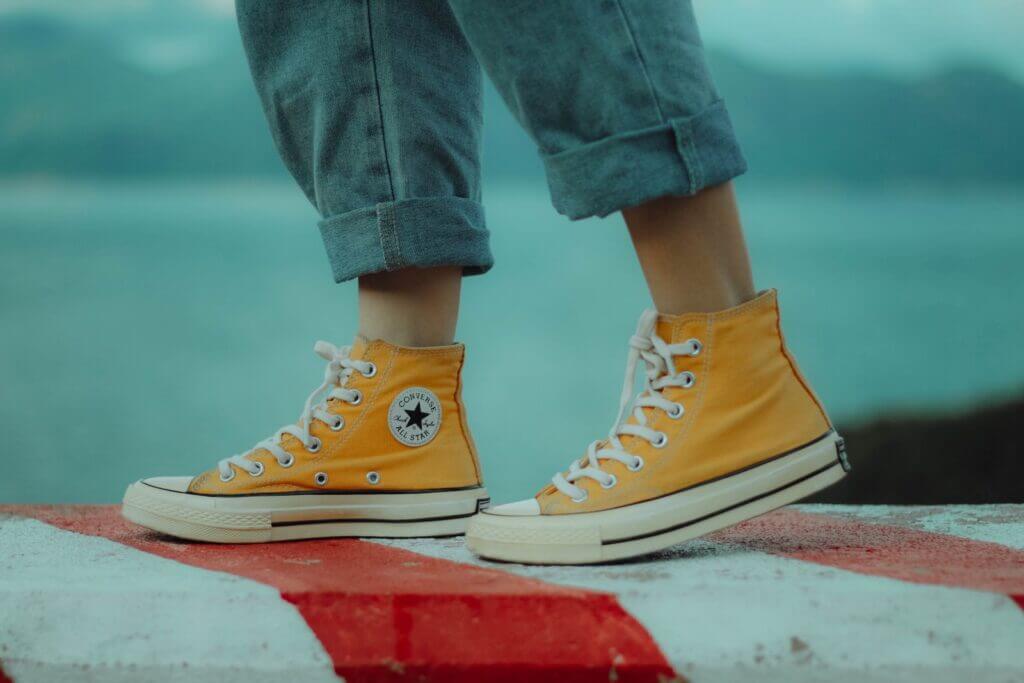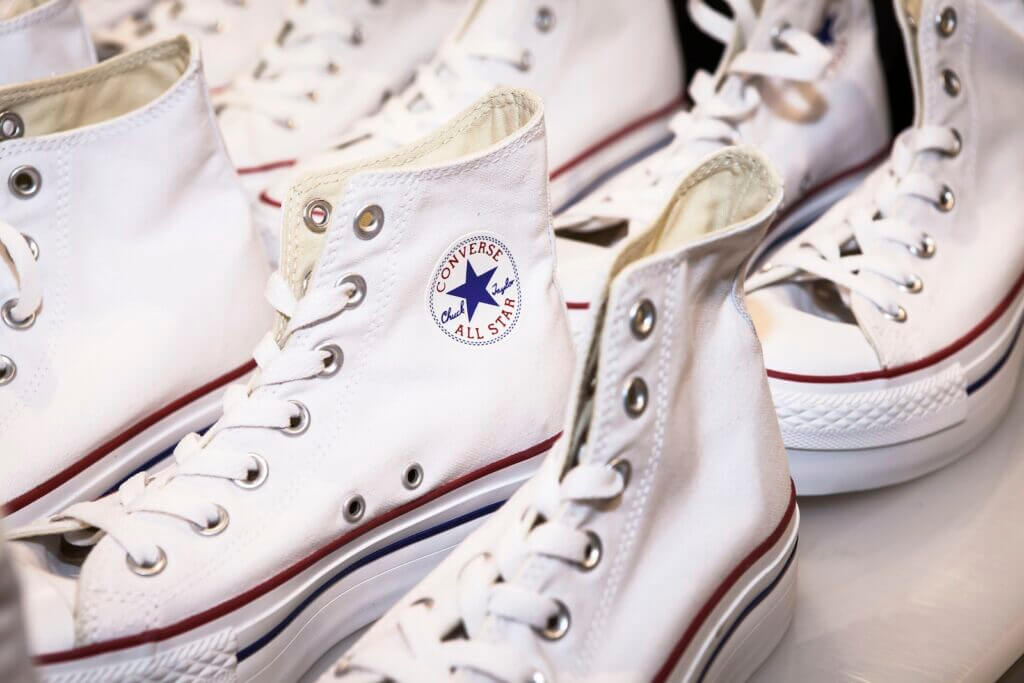If you’re a fitness enthusiast or a casual runner, you’ve probably wondered at some point whether those iconic Converse sneakers can hold up on the running track. It’s a valid question. After all, Converse shoes have become synonymous with timeless style and cultural relevance, but are they truly suitable for pounding the pavement?
In this blog post, we’ll dive headfirst into the great Converse running debate. We’ll separate fact from fiction, explore real user experiences, and provide you with a comprehensive analysis to help you make an informed decision.
So, are Converse good for running? The answer may surprise you. While Converse shoes are undoubtedly trendy and versatile, their design and features don’t align perfectly with the specific needs of runners. However, that doesn’t mean they’re completely off the table. There are certain scenarios where Converse can be a viable option for short-distance running or as part of a cross-training routine.
If you’re curious to learn more about the performance, comfort, and potential limitations of running in Converse, keep reading. We’ll guide you through the pros, cons, and practical recommendations, ensuring you have all the information you need to lace up your shoes and hit the track with confidence.
Table of Contents
What Are Converse Shoes?

Converse shoes, also known as Chuck Taylors or simply “Chucks,” are iconic sneakers that have been around for decades. They were originally designed as basketball shoes in the early 20th century but have since become popular as a fashion statement and casual footwear.
The distinctive features of Converse shoes include a canvas upper, a rubber sole, and a classic lace-up design. They come in various colors and patterns, allowing individuals to express their unique style.
While Converse shoes are beloved for their timeless appeal and versatility, they are not specifically designed as running shoes. They lack the advanced cushioning, support, and stability features that are crucial for running long distances or engaging in high-intensity activities.
However, some individuals may find Converse shoes suitable for light jogging or short-distance running due to their lightweight nature and flexibility. It’s important to note that personal comfort and preference play a significant role in determining whether Converse shoes are appropriate for running.
If you’re serious about running, it’s advisable to invest in purpose-built running shoes that provide the necessary support and cushioning to protect your feet and joints during workouts.
Can You Run In Converse Shoes?

Absolutely! You can definitely run in Converse shoes. While they may not be specifically designed for running, they can still serve as a viable option for casual jogging or shorter distances. It’s important to understand the pros and cons before lacing up your Converse sneakers for a run.
Firstly, let’s talk about the reasons why people choose to run in Converse shoes. One of the main advantages is their versatility. Converse shoes, with their flat soles and minimal cushioning, offer a firm and stable platform for running.
This can be beneficial for individuals who prefer a more “barefoot” running experience, as it allows for better ground contact and a more natural foot strike. Additionally, Converse shoes are lightweight, making them comfortable for shorter runs and quick workouts.
However, it’s crucial to consider the limitations of Converse shoes when it comes to running. The lack of specialized cushioning and support means they may not provide adequate shock absorption or protection for longer distances or intense training. Running in Converse shoes for extended periods may increase the risk of discomfort, foot fatigue, and even potential injuries such as shin splints or plantar fasciitis.
To better illustrate this, imagine running on a rough, uneven trail for several miles in Converse shoes. Without the cushioning and support of running-specific shoes, you may experience a higher impact force on your feet and joints. This can lead to discomfort and potential injuries, hindering your overall running experience.
Are Converse Good For Running?
Let’s address the question head-on: Are Converse good for running? The answer, unfortunately, is no. While Converse shoes may be stylish and popular for everyday wear, they are not designed with the specific features and technologies that make running shoes suitable for athletic activities. Here are a few reasons why Converse shoes may not be the best choice for running:
1. Lack of Cushioning and Support
When it comes to running, proper cushioning and support are essential to absorb the impact of each step and protect your feet from potential injuries. Unlike dedicated running shoes, Converse sneakers often lack adequate cushioning in the midsole and heel areas. This lack of cushioning can lead to discomfort and increase the risk of foot pain, shin splints, or even stress fractures, especially during longer runs or intense training sessions.
Imagine running on a hard surface like concrete with thin-soled shoes versus running with well-cushioned running shoes designed to absorb the shock of each stride. The difference in impact can be significant and can affect your overall running experience.
Read: Running with Tennis shoes
2. Insufficient Arch Support
Arch support plays a crucial role in maintaining proper foot alignment and preventing overpronation or supination. Converse shoes typically have a flat insole with minimal arch support, which may not provide adequate stability for runners. Without proper arch support, the feet can become fatigued more quickly, leading to discomfort and potential issues such as plantar fasciitis.
Think of it like trying to hike a mountain without the right pair of boots. Your feet need proper arch support to distribute the pressure evenly and keep you comfortable and stable throughout the journey.
3. Poor Traction and Grip
Another factor to consider when choosing running shoes is traction. Running requires a firm grip on the ground, especially during outdoor runs on different terrains. Converse sneakers, with their flat and smooth outsoles, may not offer the necessary traction needed for a secure footing. This can be particularly problematic on wet or slippery surfaces, increasing the risk of slipping and potential injuries.
To put it into perspective, imagine trying to navigate a muddy trail or sprinting on a wet track with shoes that lack adequate grip. Your performance and safety could be compromised.
4. Durability and Longevity
Lastly, Converse shoes, while fashionable, are not built to withstand the rigors of regular running. Running shoes are engineered with durable materials and reinforced areas to ensure longevity and support for the repetitive impact of running. On the other hand, Converse sneakers may wear out quickly, especially if subjected to intense running or frequent use. The lack of proper construction and materials can result in reduced performance and the need for more frequent shoe replacements, which can become costly over time.
While Converse shoes may be a popular choice for casual wear and fashion-forward individuals, they are not the ideal option for running. The lack of cushioning, arch support, traction, and durability makes them ill-suited for the demands of running.
If you’re serious about running and want to prevent discomfort or potential injuries, it’s essential to invest in a proper pair of running shoes specifically designed to provide the necessary support, cushioning, and traction.
When Can You Wear Converse For Exercise?

The answer is simple: you can wear Converse for exercise in certain situations. While Converse shoes may not be specifically designed for running or intense workouts, they can still be suitable for certain types of exercises.
One scenario where you can confidently wear Converse is during low-impact activities or casual workouts. These include activities like walking, light jogging, weightlifting, or participating in a yoga or Pilates class. Converse shoes offer decent support and flexibility for such exercises.
For instance, if you’re going for a leisurely walk around the park, Converse shoes can provide the comfort and style you desire. The rubber sole offers some cushioning, and the canvas upper allows your feet to breathe. Plus, they come in various colors and designs, so you can add a touch of personal flair to your workout attire.
Similarly, if you’re hitting the gym for a weightlifting session, Converse can be a suitable option. They provide a stable base and good traction, allowing you to maintain proper form and stability during exercises like squats or deadlifts. Their flat soles contribute to a solid connection with the ground, which is crucial for lifting heavy weights safely.
It’s important to note that when engaging in higher-impact activities like running, Converse may not offer sufficient support and cushioning for everyone. If you’re a serious runner or frequently engage in high-intensity workouts, investing in proper running shoes is highly recommended. Running shoes are specifically engineered to absorb impact, provide optimal cushioning, and offer specialized support for your feet.
However, if you’re just starting to incorporate jogging into your routine or going for shorter runs at a moderate pace, wearing Converse shoes can be acceptable. They can serve as a temporary solution until you decide to invest in a dedicated pair of running shoes. Just be mindful of any discomfort or pain in your feet or joints and make the necessary adjustments if needed.
Tips On Choosing A Pair Of Converse For Running

When it comes to choosing a pair of Converse for running, there are a few key factors to consider. While Converse shoes are primarily known for their classic style, they can also be a viable option for running if you make the right choice. Here are some practical tips to help you select the best pair for your running needs:
- Look for Proper Cushioning and Support
Running involves repetitive impact on your feet, so it’s essential to find a pair of Converse shoes that offer adequate cushioning and support. Look for models with a well-padded insole and a responsive midsole that can absorb shock. These features will help protect your feet and joints from the impact of each stride.
For example, the Converse Chuck Taylor All-Star II model provides improved cushioning compared to the classic Chuck Taylor design. It features a Lunarlon sock liner that offers enhanced comfort and support during running.
- Consider the Outsole Grip
Good traction is crucial for running shoes, as it ensures stability and helps prevent slips and falls. Check the outsole of the Converse shoes you’re considering and look for a pattern that provides reliable grip on different surfaces. This is particularly important if you plan to run on wet or uneven terrain.
Converse’s All Star Pro BB model, for instance, incorporates a grippy outsole with a herringbone pattern, which offers excellent traction on both indoor and outdoor running surfaces.
- Find the Right Fit
A proper fit is vital for any running shoe, including Converse. Ill-fitting shoes can lead to discomfort, blisters, and even injuries. Make sure to measure your feet accurately and refer to Converse’s sizing guide to find the right size.
Keep in mind that your feet may swell during running, so it’s generally recommended to choose running shoes that are slightly larger than your everyday shoes. This will allow for adequate toe room and prevent your feet from feeling cramped.
- Test for Flexibility and Breathability
Flexibility and breathability are essential factors for running shoes. You want a pair that allows your feet to move naturally and keeps them cool during your runs. When considering Converse shoes for running, check if the upper material allows for sufficient flexibility and if it provides adequate breathability.
For example, the Converse Run Star Hike model features a mesh upper that promotes breathability, allowing air to circulate and preventing excessive sweating during your runs. It also offers a flexible sole that enhances natural foot movement.
While Converse shoes may not be specifically designed as running shoes, with the right considerations, you can find a suitable pair for your running needs. Prioritize cushioning, support, outsole grip, proper fit, flexibility, and breathability when making your choice.
By selecting the right Converse model that meets these criteria, you can enjoy comfortable and enjoyable runs while still sporting the iconic Converse style.
FAQ
Is it OK to workout in Converse?
Yes, it is generally okay to work out in Converse shoes. However, keep in mind that Converse shoes are not specifically designed for intense workouts or high-impact activities. They lack the cushioning and support features found in dedicated athletic shoes. If you engage in activities that involve a lot of jumping, running, or lateral movements, it’s advisable to opt for shoes with better support and shock absorption.
Can you run fast in Converse?
While it’s possible to run in Converse shoes, they are not optimized for running fast or long distances. Converse shoes lack the specialized features, such as cushioning, stability, and arch support, that are crucial for running performance and injury prevention. If you’re serious about running and aiming for speed, it’s recommended to invest in proper running shoes designed for the specific demands of the sport.
Can you use Chuck Taylor for running?
Chuck Taylor shoes, a popular Converse model, are not designed or intended for running. They lack the necessary features to provide the support, cushioning, and stability required for running activities. While Chuck Taylor shoes have a classic and fashionable appeal, it is best to use them for casual wear rather than running.
Is Converse an athletic shoe?
Converse shoes are not primarily designed as athletic shoes. They were originally designed as basketball shoes but have since gained popularity as casual and fashion footwear. While Converse shoes can be suitable for light exercises, they generally lack the specialized features and support that athletic shoes provide. If you participate in specific athletic activities or sports, it’s recommended to choose footwear designed for those purposes.
Are Converse Good For Your Feet?
Converse shoes may not provide adequate support for everyone’s feet. They typically have flat soles and minimal arch support, which can be insufficient for individuals with certain foot conditions or those who require additional support. It’s important to consider your foot type, any existing foot conditions, and personal comfort when deciding if Converse shoes are suitable for you. If you have specific foot concerns, consulting with a podiatrist or footwear specialist is advised.
Is Converse Good For Walking?
Converse shoes can be comfortable for walking short distances or for casual outings. However, for extended walking or for individuals with foot conditions, they may not offer the necessary support or cushioning. Walking shoes with proper arch support, cushioning, and shock absorption are generally recommended for longer walks or for individuals who require additional foot support.
Final thoughts
After thoroughly examining the question, “Are Converse good for running?”, it’s clear that the answer depends on various factors. While Converse sneakers have a loyal following and iconic status, they may not be the best choice for serious or long-distance runners.
Converse shoes lack some key features that are essential for optimal running performance. They have minimal cushioning, arch support, and stability features, which can lead to discomfort, fatigue, and even potential injuries during intense or extended running sessions.
However, if you’re an occasional runner or prefer a minimalist shoe style, Converse can still serve as a viable option for light jogs or casual runs. They offer flexibility, breathability, and a distinctive aesthetic that appeals to many athletes.
Ultimately, it’s crucial to prioritize your comfort, safety, and individual needs when selecting running shoes. If you’re a dedicated runner or planning to embark on a rigorous training routine, it’s recommended to invest in purpose-built running shoes that provide the necessary support, cushioning, and stability.
You might also like


